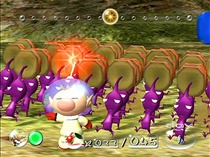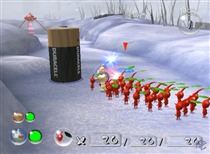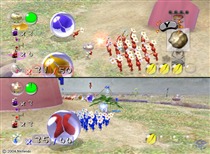We take a look back at the games worthy enough to be considered GameCube's best.


Pikmin
Released December 2, 2001
Developed by Nintendo
Published by Nintendo
Retrospective by Evan Burchfield
Pikmin is a divisive game. Its ability to move gamers is dependent on how much one has embraced the Nintendo philosophy of game design as preached by its Archbishop Shigeru Miyamoto. Featuring a small player character who wanders around a foreign world, an army of alien plant-creatures, and giant monsters, Pikmin seems to falsely advertise itself. It does not feature fast-paced action, tactical strategy, or even platform jumping. As a result, the game contributed to the derision of Nintendo by non-Nintendo gamers. Nonetheless, the Nintendo fans loved it. Pikmin therefore represents the cultural divide between the Nintendo fan and the hardcore gamer.
Pikmin helped solidify the New Miyamoto Vision, the old philosophy of design made new on GameCube. It is summed up by three design necessities: simplicity of story, immediacy in play control, and delayed depth. Of course, each of these elements has been a part of Miyamoto's philosophy from the beginning, but modern gaming began to question these ideas with the advent of 3D, full motion video, and expanded disc capacity, all of which resulted in longer and more complex games that emulated movies instead of blazing their own path.
The first element, simplicity of story, is contradictory to the majority view. Miyamoto has managed to hold his ground despite the changing winds; as stories get more complex and sandbox games allow us to take our stories out of order, Miyamoto has allowed only the gameplay to approach non-linearity, and only when the story is on pause. Pikmin embodies the ideal Mario-style story – one goal, no twists, many obstacles. Just as Mario sought the Princess, Captain Olimar seeks freedom from a strange planet. He must gather the pieces of his spaceship to escape, utilizing the Pikmin to accomplish this goal. Via a private journal we are treated to daily updates of Olimar's feelings, causing his sense of isolation, discovery, and beauty to become ours – all without long cinemas or dialog.
In a game where you must control a large group of sentient creatures, most developers would merely use menus for play control. The New Miyamoto Vision demands that play control causes immediate actions on screen – Olimar can therefore whistle at or throw the Pikmin to control them, and their responses are based on their surroundings; if they land near a wall, they'll break it down, but if they land near an enemy, they'll kill it. Also in line with Miyamoto's game design is a player character: Olimar is controlled directly and has his own health, and it is his effect on the Pikmin that matters. Playing as Pikmin would not induce the same amount of wonder, nor would a top-down real time strategy presentation. In terms of play control, Pikmin is such a genre mishmash that it has no genre, and no other game has attempted to replicate its originality.
The final step in the New Miyamoto Vision is delayed depth, something that can be termed "No Depth" when applied to Nintendo's recent non-gamer games. In Pikmin there are only three different types of Pikmin, and their functions are simple. The world can be laid out as a giant puzzle map where Yellow Pikmin must use bombs to break down a wall so that Red Pikmin can destroy a fire-breathing monster to let the Blue Pikmin swim across a lake and grab the spaceship's next part. No part of the game truly challenges your brain until the final area, which is like a giant Rubik's Cube that must be unlocked in stages to complete. Until then the main challenge of the game is to achieve the individual tasks within the time limit. Olimar only has a few days to restore his ship, and each day is limited to morning, noon, and evening. At night monsters rule the ground, and Pikmin are likely to become their midnight snacks. The sense of urgency as well as the limited speed of Pikmin workmanship kept the game moving towards its goal, but it was never truly difficult. The game was praised as a good introduction to gaming for middle-aged people and a somewhat relaxing experience, something that the game's excellent ambient soundtrack supported.
Miyamoto was already considered an auteur of video games by the time GameCube launched, and stories of Miyamoto getting the idea for Pikmin while gardening reinforced his "creator" status. The game was also unique since it was essentially nonviolent – though there were enemies to destroy (and destroying them looks comically barbaric), you mostly wandered around with your Pikmin and accomplished generally one task per day. The sense of wonder and discovery were emphasized over combat and violence. Although Nintendo has always claimed that their philosophy was "gameplay first," they themselves have ignored what that really means: the effect a game has on players is, like all art, the ultimate goal. Miyamoto realizes that gameplay is the way to affect players in a video game, with art/sound design and story as its tools. If we are actively participating in the game's narrative and world it doesn't matter how simple the remaining elements are. Pikmin is a testament to Nintendo's ability to actually make people feel, something that all good games do. And since Olimar is in reality stranded on planet Earth, we gain a new perspective on the lower orders of our world, perhaps the same perspective that the great video game author Shigeru Miyamoto had while he was working in his garden.
Thoughts From the NWR Staff
Daniel Bloodworth: "Pikmin has this sense of loveable charm to it. While the day/night system was a turn off for some, Olimar's diary entries gave the adventure a personal touch not usually found in puzzle or strategy games. Plus the Pikmin themselves are so adorable that to watch any of them fall in battle touches your heart with a sense of tragedy.
Pikmin was the first game I ever reviewed for NWR. I had been hired some time after the game came out, and there was already a review done, but I wrote it just to give it a shot and see if I'd be any good at it. Now I've written dozens of articles for the site and have spent a few years editing everyone else's too."
David Trammell: "Pikmin wasn't just a game, it was a finely crafted experience. At its core, Pikmin can be thought of as an RTS with a unique and finely executed method of control. When's the last time you played an RTS and felt guilty when you accidentally directed a number of "units" into a watery grave? The personality of the Pikmin and Olimar's journal entries really make the experience."
Jonathan Metts: "When I first played Pikmin, a few weeks after the GameCube launch, the game held a strange and irresistible grip over me. It was the first game I had played in years that completely took over my body and mind, to the point that I was declining meals with my family and nearly ditching sleep until I had played through the entire game twice, consecutively."
Lasse Pallesen: "Creating Pikmin was a bold move by Nintendo for a number for reasons. Besides being a totally original game, Pikmin was based on gardening and belonged in the real-time strategy genre, which didn't exactly have a thriving history on consoles. A lot of resources had to be used to overcome these challenges, which was also reflected in the relatively high development costs of the game. Fortunately, Pikmin didn't disappoint. Nintendo showed us that not only were they still interested in creating new original franchises and not just sequels, they also still had the skills to do so."
Michael Cole: "I am not a fan of RTS games, but with its puzzles and endearing story, Pikmin is an exception. Instead of fierce battles of swords or bullets, Pikmin offers a dash of organic warfare and an entree of exploration. Slowly discovering the true nature of Olimar's strange new planet and fighting the clock to fix his tiny ship was a truly memorable experience."
A Dissenting Opinion
Steven Rodriguez: "I used to be a pretty hardcore Command & Conquer player back in the earlier days of PC gaming, but I had since fallen out of favor with RTS games. The whole genre just didn't appeal to me anymore. Pikmin didn't really change that for me. Despite the praise the game received, the I held no interest in that manner of gameplay. Even Miyamoto's vision wasn't enough to convince me to come back to the genre."
The follow-up to Pikmin discarded some of the original's core facets but implemented new ones to balance. Pikmin 2 was essentially the same game, except this time collecting items gained money for Olimar's company, who wanted to loot the planet for their personal gain. Olimar was joined by a sidekick who could control a separate group of Pikmin; switching between the two was accomplished by a button press. Also added were new types of Pikmin whose abilities brought new types of puzzles and interactions with the environment. Since this upped the complexity quite a bit, the time limit was removed and the majority of the game took place in deep underground caves. Pikmin 2 is overall more of a gamer's game and is intended to appeal to those who played through the first Pikmin but sought a higher difficulty level. Miyamoto seems committed to Pikmin as a franchise, and further sequels for Wii can be expected. Both Pikmin and Pikmin 2 eventually received Player's Choice status.







